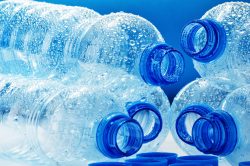 By using a new method for assessing BPA levels in the human body, scientists are now suggesting that our exposure to this industrial chemical is much higher than previous estimates. Following a recent study, they believe that regulators such as the FDA could be relying on measures that have underestimated those levels by as much as 44 times.
By using a new method for assessing BPA levels in the human body, scientists are now suggesting that our exposure to this industrial chemical is much higher than previous estimates. Following a recent study, they believe that regulators such as the FDA could be relying on measures that have underestimated those levels by as much as 44 times.
BPA is a chemical that is present in a variety of consumer products including plastic containers for food and beverages and is also found in epoxy products. In the human body it is an endocrine disruptor which means it interferes with hormone functions in the body.
It is only in the last few years that scientists have begun to understand how BPA and other endocrine disruptors can affect human health. Once BPA enters the body, it breaks down quickly into metabolites. To accurately asses BPA exposure, scientists much take metabolites into consideration.
In the study, the team explains that agencies such as the FDA are still relying on analytical techniques that indirectly assess BPA metabolite levels. When the team compared those techniques to newer ones that measure BPA metabolites directly, the results were very different.
Studies on animals have shown that BPA can disrupt the normal healthy functioning of hormones in the body. Exposure to BPA during gestation has been linked to changes in a variety of developing tissues with corresponding postnatal effects on metabolism, growth, fertility, behavior and cancer risk.
The studies that the FDA has relied on use an indirect analytical technique for measuring BPA in humans. This method uses an enzyme solution from a type of edible snail. The snail enzyme solution converts BPA metabolites in urine back into the parent compound. Scientists then use liquid chromatography mass spectrometry to measure total BPA. Total BPA comprises free BPA and BPA reconstituted from its metabolites.
The research team note that while its widespread use, the efficiency with which the snail enzyme solution converts metabolites back to BPA has never been assessed. The team compared the snail enzyme method with a method that accounts for BPA’s metabolites more directly without the conversion back into the parent compound.
They tested the two methods first in synthetic urine and then in 39 human urine samples which included 29 from women who were pregnant. The results showed that the direct measurement detected significantly higher levels of BPA, as much as 44 times higher than the last geometric mean for adults in the United States.
They also saw that the disparity between the indirect and direct methods increased with higher levels of BPA. This means that the more BPA inside the body, the more likely the indirect method will show a lower reading. This is the first data to provide evidence that the indirect method is a flawed analytical tool for measuring BPA levels.
The research team is also concerned about other chemicals including ones that manufacturers use in place of BPA. They are worried because regulators are relying on the indirect method to asses the human exposure to those chemicals as well.
The hope is this new study will bring attention to the current methodology used to measure BPA and that other experts and labs will take a closer look at and assess independently what is happening. It certainly raises serious concerns about whether regulatory agencies are careful enough about the safety of BPAs
In addition to continuing to investigate BPA, the researchers plan to apply the direct method to a variety of chemicals found in every day products such as toys, soap, cosmetics, food packaging and other personal care items. These chemicals include parabens, triclosan, phthalates, and benzophenone.
To view the original scientific study click below
BPA: have flawed analytical techniques compromised risk assessments?





